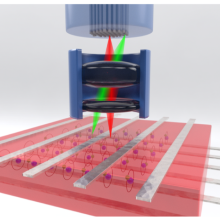An exciton is an excited state of the crystal in which an electron and a hole form a quasiparticle bound by Coulomb interaction. If an exciton is in a state with large principal quantum number, it is termed Rydberg exciton. Rydberg excitons in the semiconductor cuprous oxide (Cu2O) exhibit principal quantum numbers as high as n=25 and excitonic Bohr radii in the micrometer range. They are capable of sensing elementary excitations in their surrounding on a quantum level.
These giant single quantum objects in cuprous oxide have been discovered only recently, and their potential as quantum devices has yet to be realized. Many properties of this system are unknown and still have to be determined.
At the 4th Physics Institute we establish schemes to quantitatively determine and modify Rydberg exciton interaction by using pump-probe excitation. We combine Rydberg excitons with plasmonic antennas to enhance quadrupole transitions. We are going to mill quantum wells into the surface of the semiconductor using focused ion beam milling and measure energy shifts. We will equip the semiconductor with 3D-printed phase plates to measure the excitation of higher orbital momentum Rydberg excitons. And, we couple the semiconductor with optical fibers via 3D-printed fiber chucks and microoptics in order to build an integrated and scalable solid state quantum device.
This project is funded by DFG Schwerpunktsprogramm Giant interactions in Rydberg Systems (GiRyd).
PhD student

Annika Neubauer
Dr.Excitonic Rydberg spectroscopy


